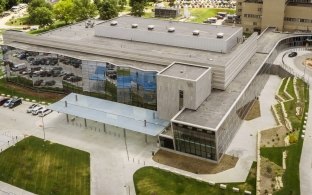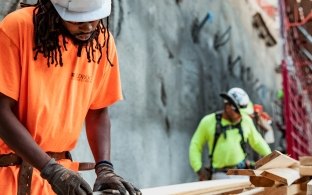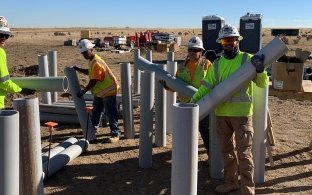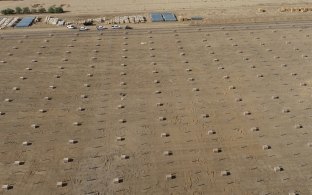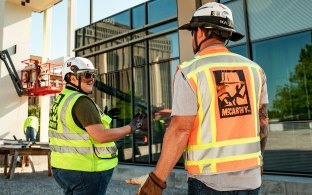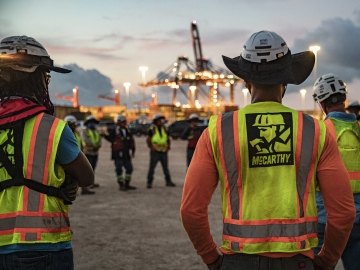Building a Better Infrastructure for Learning
How a continuous improvement culture increases certainty and improves outcomes.


Construction continues to be one of the world’s most rapidly evolving industries. Maximizing the value of new technologies, and building techniques and leadership skills is essential for delivering today’s most complex projects.
How can owners ensure their builder is ready to embrace and adopt change to accomplish their goals? By choosing a partner with a strong learning infrastructure and culture of continuous improvement.
Most organizations have processes built around training, but lack a true cultural commitment to learning and development. When continuous improvement is ingrained within a builder’s culture, they can seamlessly capitalize on industry changes and trends for the benefit of all project stakeholders.
Laying the Foundation
A continuous improvement culture is more than an approach to learning and development — it’s an organizational commitment to how all work is approached.
From the simplest task to a review of the entire project life cycle, there is no such thing as a one-time learning event. With this mindset, learning and development are more than required courses or training sessions. They are a proactive solution that enhances outcomes for clients, trade partners, and the builder.
Executing such a commitment requires a robust infrastructure of training and development professionals throughout the company, capable of implementing and guiding training for the groups they represent. With a strong learning foundation in place, project teams and company leadership can confidently rely on training as a solution instead of a roadblock.
How does it work in practice? The initial spread of COVID-19 necessitated immediate safety, quality and process changes on every construction site across the country. Training and skill-building sessions, traditionally done in person, were suddenly required to be done in virtual settings.
With a strong training infrastructure in place, McCarthy’s learning and development teams were able to pivot strategically, quickly shifting their focus to ensuring trainers understood how to teach effectively in virtual environments. The result was training teams capable of adapting in-person methods and materials for virtual audiences, already embedded with local project teams and ready to help meet the unique challenge of continuing to safely build during a global pandemic.

Blended Training Methods
Despite the broad shift toward virtual learning in response to COVID-19, many builders will likely revert to traditional in-person sessions for all training after the pandemic recedes.
On the other hand, proactive builders focused on continuous improvement are developing effective new ways to blend different methods to deliver training that meets the learner where they are and ensures maximum retention of information.
When you provide training that meets learners where they are — with exactly what they need — you increase the training’s effectiveness and timeliness.
It’s possible to take learner-focused training even further. At McCarthy, for example, we’re learning what works best for our learners, including how they access the information, when they like to train, and the time frames they can dedicate to learning. The result? It allows us to know how to deliver timely training that decreases time away from projects and allows for more immediate application and retention of the training.
One of the biggest takeaways from our data is the increasing effectiveness of informal training methods. As we analyzed our expanding craft workforce and identified the skills they needed to grow, we increasingly focused on integrating training experiences into day-to-day job site activities.
Instead of targeting learners directly, McCarthy is designing programs to help superintendents and other experienced leaders identify and guide project teams through on-site learning opportunities. Both groups broaden their respective skillsets and can immediately apply them to improve the project.
Crafting the Solution
Beyond improving safety, quality and certainty on active projects, a continuous improvement culture helps address the ongoing labor shortage in the construction industry.
There are many reasons for the shortage. One of the most significant is a craft population approaching retirement without enough professionals to replace them. Despite the industry’s best recruiting and training efforts, those gaps are often filled by unskilled workers, increasing risk and decreasing certainty — the opposite of what owners want.
For years, many in the construction industry have attempted to address the knowledge gap with rudimentary skills training. But if you ask them how they know if they have a truly skilled carpenter or pipefitter, they can’t give you an answer. The real answer lies in harnessing the power of continuous improvement.
Through a process of ongoing review, documentation and refinement, it’s possible to define the skills and outcomes required to grow new and experienced craft professionals into true masters of their trade and jobsite leaders. Those criteria are distilled into a training matrix that allows for every individual, regardless of initial skill level, to create a custom development path that matches their career goals.
At McCarthy, we’ve experienced the benefits of this approach firsthand. Our craft workforce is flourishing and staying with us. They want to work on our clients’ projects because they know and appreciate the skills and career development that come with our commitment to growing our people. Using the same training infrastructure that supported our response to COVID-19, we are applying lessons learned to new training methods that meet our craft workforce where they are. The results are the same: Quicker, more timely training and immediate opportunities to apply those lessons on active projects.
A company that demonstrates a passionate and proactive approach to the learning and development of its people and workforce will likely treat its clients the same way.
The lesson is clear: when you choose a partner with a strong learning infrastructure and continuous improvement culture, everyone wins.
About the Authors
Trina Parks
Trina is responsible for improving the safety, quality and overall execution of projects across McCarthy’s Southern Region through the building and training of a highly capable and engaged craft workforce. She has championed the implementation of new systems to effectively onboard and train craft professionals new to construction. She also designed resources and training for project teams to help promote a healthy jobsite culture while supervising initiatives to capture and model development programs to ensure craft professionals have the skills they need to excel in current roles and pursue career opportunities.
Robin Renschen
Robin is responsible for aligning learning and performance objectives to business strategy to achieve client goals. He was instrumental in the development of McCarthy’s award-winning McCarthy Build U® training and development program, leading to McCarthy’s introduction into Training Magazine’s Training Hall of Fame in 2016. He is actively involved with workforce development in the broader construction industry, and serves on the board of trustees for NCCER, the industry leader in training, assessment, certification and career development for construction and maintenance craft professionals.

